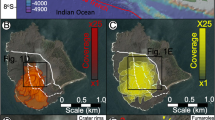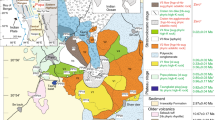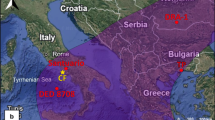Abstract
IN the interesting paper by Mr. John Murray and the Abbé Renard, which appears in your last number (p. 585), there is an erroneous reference which it may be well to correct without delay. I am made responsible for a verbal statement concerning Krakatoa dust which fell in Japan. In your issue of the 3rd inst. (p. 525) a letter from myself will be found, stating, on the authority of Prof. John Milne of Tokio, that, contrary to the original statements made on the subject, no dust of Krakatoa is known to have fallen in Japan. My friend M. Renard must have misunderstood the communication which I made to him, which was to the following effect:—I have had the opportunity of examining a great number of specimens of the dust of Krakatoa which fell at different distances from the volcano, ranging from 50 to nearly 1000 miles. The dust collected at the greatest distance from Krakatoa, with which I am acquainted, is that which fell on board the Arabella in lat. 5° 37 S. and lat. 88° 58 E., Java Head bearing E.1/2 S. about 970 miles. It is certainly true that the dust which has fallen at the greater distances from the volcano contains less magnetite, augite, and hypersthene than that descending nearer to the source of eruption; and the obvious explanation of this is found in the greater density and compactness of the particles of those minerals as compared with the associated glassy fragments. At the same time it must be remembered that this is not the only explanation of the high silicapercentage in these ashes. The prevailing rock in the islands and on the shores of the Sunda Strait appears to be a hypersthene-augite-andesite, containing an unusually large proportion of a brown, glassy base. This base contains a far higher proportion of silica than the included minerals; and hence, as shown by Verbeek and Fennema, these rocks have a percentage of silica ranging up to, and even exceeding, 70 per cent. The same is true of the pumices formed from the glassy andesitc rocks, including that of Krakatoa itself.
This is a preview of subscription content, access via your institution
Access options
Subscribe to this journal
Receive 51 print issues and online access
$199.00 per year
only $3.90 per issue
Buy this article
- Purchase on SpringerLink
- Instant access to full article PDF
Prices may be subject to local taxes which are calculated during checkout
Similar content being viewed by others
Author information
Authors and Affiliations
Rights and permissions
About this article
Cite this article
JUDD, J. The Dust of Krakatão. Nature 29, 595 (1884). https://doi.org/10.1038/029595a0
Issue date:
DOI: https://doi.org/10.1038/029595a0



